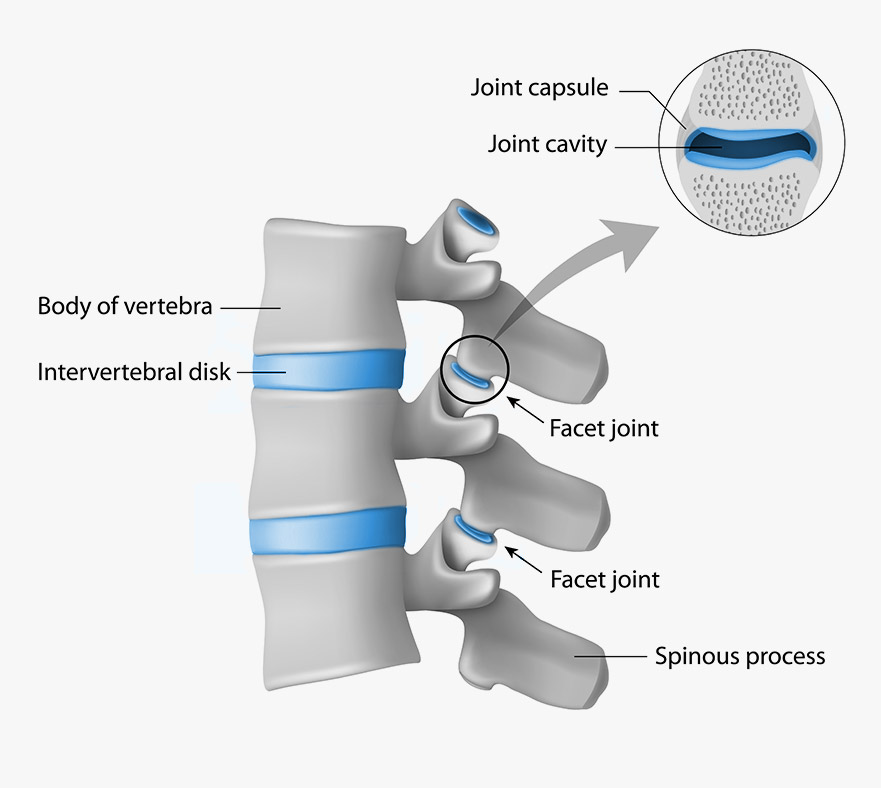Facet Joint Rhizolysis
What is Facet Joint Rhizolysis?
Facet joint rhizolysis is a procedure used to treat neck or back pain that stems from the facet joints.
It is a longer-term treatment option that can be considered after a medial branch block has proven to be successful in significantly reducing neck/lower back pain. Please see link to Facet Joint Injections and Medial Branch Blocks for further information.
This procedure uses radiofrequency waves to heat and deactivate the medial branch nerves that are located around your facet joints. These nerves usually send pain signals to your brain; the procedure aims to interrupt/stop the pain signals being sent.

What happens before the procedure?
Before being referred for facet joint rhizolysis, you will need to be assessed by a specialist surgeon or practitioner and have previously experienced an improvement in your symptoms following a medial branch block.
In a majority of cases, imaging of your spine, such as an MRI scan, will have been carried out and will not need to be repeated unless there has been a change in your symptoms.
How do I prepare for my procedure?
Please inform us if you take a blood thinning medication when you arrange your appointment as some need to be temporarily withheld beforehand. Common blood thinning medications include antiplatelets (aspirin or clopidogrel) and anticoagulants (warfarin, apixaban, dabigatran, or rivaroxaban).
Do not stop any medication before talking to us.
Diabetics should closely monitor their blood sugar level before and after the procedure as the steroid medication in the injection can affect this for several days.
You will need to arrange for someone to bring to you to the hospital and to drive you home after the procedure. Ideally you should have someone stay with you for 24 hours after your appointment.
You should not drive for 24 hours following the procedure.
What does the procedure involve?
Facet joint rhizolysis is performed in the hospital as an outpatient under local anaesthetic and you will go home the same day.
You will not require sedation or general anaesthetic.
A specialist doctor (Radiologist) will carry out the procedure in a room with a special X-ray camera, called fluoroscopy.
You will be asked to lie on your front for the procedure, we will aim to make you as comfortable as possible. The doctor will then clean the skin on your neck/back with antiseptic and cover with sterile drapes.
The skin/tissues of the affected area of the neck/back will be injected with local anesthetic to numb the area and reduce any pain. The doctor will then guide a specially designed radiofrequency needle next to the medial branch nerves, guided by X-ray images.
The doctor will then pass a tiny electric current down the needle to confirm placement next to the target nerve. This can sometimes reproduce usual back pain.
The doctor will then numb the nerves with local anaesthetic to minimize pain.
The radiofrequency waves will then be applied to heat the tip of the needle and destroy the required nerve endings. This helps to block/disrupt pain signals from the nerves reaching the brain.
The process may then be repeated if different areas need treating at the same time.
Sometimes, more local anaesthetic and steroid is injected to help with any discomfort that you might experience afterwards.
The procedure can last up to an hour, depending on how many areas need treating.
How will I feel after the injection?
Immediately after the procedure, some people experience a burning/sensitivity at the treated area, similar to sunburn. There may also be some numbness.
You will usually be able to go home half an hour after the procedure is finished.
What are the risks of the procedure?
Sometimes, people experience an increase in pain for up to a couple of weeks after the procedure. This usually settles down with usual pain medication, gentle mobilization, and intermittent ice packs.
The response to the procedure (like with many spinal surgical interventions) varies from person to person. The ablation often helps reduce pain enough to allow you to mobilise better and undertake physiotherapy/rehabilitation.
There is a small risk of pain, infection, bleeding, nerve damage, and an allergic reaction to the medications used. There is also a slight risk of small burns from the heated needle.

